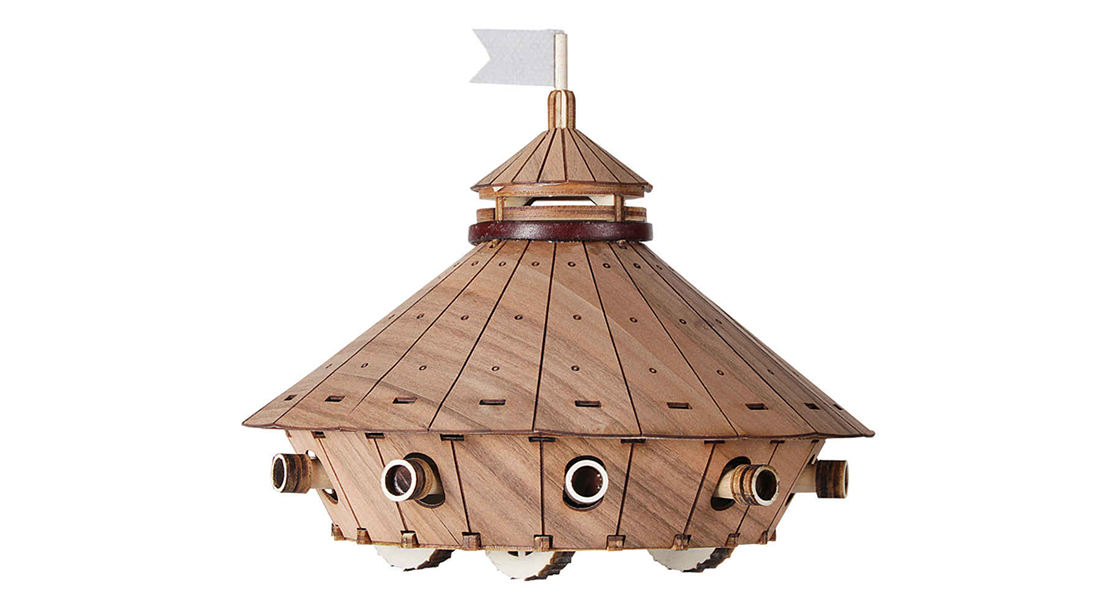Tank
Leonardo da Vinci, Codex Arundel, folio 1030, c. 1485 British Museum. Project for a "covered wagon”.
Conceptually, the idea of a covered wagon (as Leonardo calls it), capable of containing weapons of offense inside, is very ancient. In this, as with some of his other ideas, the Tuscan genius is concerned with proposing an idea capable of surprising. This is a project for a weapon that no one had ever even imagined and capable of sowing terror among enemies. However, Leonardo does not offer us very detailed elements, as if he were aware of the enormous difficulties involved in making such a weapon operational and, therefore, reduces everything to two images: the one that shows the terrifying impact of the many cannons mounted on the 360º of the circular structure; and the one that offers a cross-section of the inside with the possible mechanism to make it move.
There are no measurements or references other than the guns, as if he wanted to make it clear that the project was the basis for building a more or less large weapon. The problem, in fact, of which Leonardo was certainly aware, is that the more one wants to make it effective, the greater the number of guns must be; consequently the structure of the wagon will be larger and, therefore, more difficult to maneuver and move. In Leonardo's drawing there are no less than 36 guns, we have foreseen 10.
The upper part of the tank can be fixed with glue and become a single body or, if left free, which we recommend, so that you can see and show the inside of the tank. The turret can also be fixed to the body of the wagon or left free using only the relative joints for stop.
Correlati
Tank
This is probably the most controversial and mysterious Leonardo drawing that has been discussed since its discovery, which took place in a fortuitous and unexpected way, between 1966 and 1968, in the laboratory of restoration of ancient books of the Esarchico Monastery of Santa Maria di Grottaferrata (Rome).
Tank
This is not a completely new invention, but the optimization of an existing weapon. In fact, at the time of Leonardo bombards were used in sieges. Their large mouth allowed them to fire large bullets that could easily open large breaches in enemy defenses. However, the machines were very heavy and took a long time to maneuver.
Tank
Undefined scale interpretation of Leonardo da Vinci's project, Codex (Codex) Windsor 1265r, 1485 ca.
Tank
The mowing wagon is one of the two war machines designed by Leonardo in 1485 and included in the file for Ludovico il Moro, Duke of Milan, as a presentation of his skills that he intended to put at his service.
Tank
The model, all in wood, is equipped with an ingenious device that allows the movement of the wings and the body. This device, with its magical appearance, is very instructive and fun to assemble.
Tank
In the 1950s, Harold Edgerton, a professor of electrical engineering at the Massachusetts Institute of Technology, combining strobe lights with a camera equipped with a high-speed film advance motor, studied the way to capture images invisible to the naked eye, that is, those that they are formed when a drop falls on a flat surface: the human eye sees the sequence that develops in a fluid way, but is unable to capture all the images of which it is composed.
Tank
THE ORNITHOTTERY OR FLYING MAN is a tribute to the genius of Leonardo da Vinci. To his skills as an inventor, to his technical and artistic skills, to his refined aesthetic taste. It is the recognition of his continuous studies, the search for beauty, balance and the measure of things that make life pleasant. It is the result of a long technical and image study, as well as a patient synthesis that took into account not only the intuitive aspects of Leonardo's flight, but also of the Tuscan culture.
Tank
Able to jump, like all crickets, and to run fast, because equipped with two large "mountain bike" wheels, however, it finds its rightful place in a sort of throne from which he can devote himself to his passion as a nuisance, talking and moving at the same time .
Tank
Studied from the Vitruvian Man in wood and leather. Undefined scale model from: Leonardo da Vinci, “Vitruvian Man”, c. 1490. Accademia Gallery, Venice.
Tank
Assembly kit for the construction of a model (in undefined scale) of the study of a self supporting bridge by Leonardo da Vinci. We started from Leonardo's drawing found in the Codex Atlanticus and built a bridge model based only on two repetitive modules.
Tank
Wooden model in assembly box. Easy and fun to assemble. Beautiful looking. And then: "yes it flies" ... or do you read “do we fly"? You decide.
Once mounted, it flaps its wings, moves a leg, and is happy ... Who is happy: him? You? your son? your daughter? Maybe everyone: “LET'S FLY"
Tank
Almost magical ancient automatic machine ... indeed, very magical
Tank
Model (on undefined scale) for didactic purposes by Leonardo da Vinci on the transformation of motion, found in the Madrid Codex f 17r
Tank
Study in wood, leather and non-woven fabric. Undefined scale model by Leonardo da Vinci, manuscript B, folio 83 v., (1485ca.), Codex Atlanticus, Biblioteca Ambrosiana, Milan.
STAY UP TO DATE
Subscribe to the newsletter to not miss the latest news.
